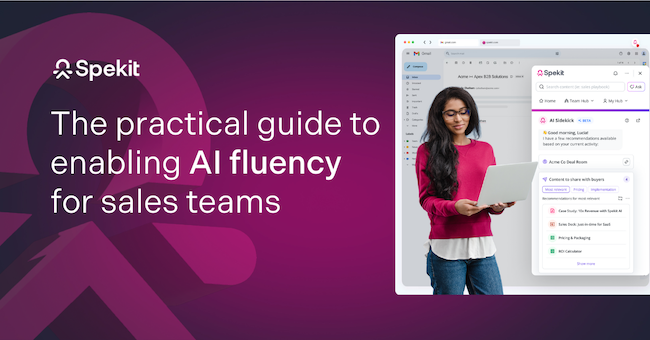Introduction
In today's competitive sales landscape, leveraging artificial intelligence (AI) can be a game-changer for sales enablement professionals. AI tools like ChatGPT, Claude, Perplexity, and Google Gemini can streamline tasks, generate insightful content, and enhance team performance. This report presents seven high-powered AI prompts designed to help you save time, increase efficiency, and empower your sales teams to achieve better results by strategically utilizing different AI tools for specific tasks.
The Importance of Providing Context in AI Prompts
The effectiveness of AI-generated outputs is highly dependent on the quality and depth of context provided in your prompts. For sales enablement professionals, this means incorporating specific information about your company, products, services, target markets, and customer pain points.
Tactical Strategies for Adding High-Quality Context
- Prepare a Context Library: Create a repository of essential information about your company, products, and market. This can include product brochures, customer personas, value propositions, and competitive analyses.
- Use Structured Templates: Incorporate placeholders in your prompts where you can easily insert context. For example, [Insert Product Features Here] or <company_overview>.
- Be Specific and Detailed: The more precise the context, the better the AI can tailor its responses. Instead of saying "our product," specify "our cloud-based CRM solution designed for small businesses."
- Update Regularly: Ensure that the context information is current. Outdated data can lead to irrelevant or inaccurate AI outputs.
- Leverage Confidentiality: While adding context, be mindful of sensitive information. Use generalized data when necessary to protect proprietary information.
By systematically adding high-quality context, you enhance the AI's ability to generate outputs that are relevant, accurate, and actionable.
Leveraging Different AI Tools for Maximum Impact

Not all AI tools are created equal; different tasks may require different capabilities. Tools like Perplexity and Google Gemini offer live internet research capabilities, which can be invaluable for up-to-date information and competitive insights. Understanding which tool to use and when can significantly improve efficiency and output quality.
Strategic Use of AI Tools
- ChatGPT (OpenAI ChatGPT) and Claude (Anthropic Claude): Ideal for generating creative content, drafting communications, and developing training materials based on provided context.
- Perplexity (Perplexity AI) and Google Gemini (Google Gemini): Best used when you need the most current information, such as recent market trends, competitor updates, or industry news, as they can access live internet data.
- Multi-Step Approaches: Combine the strengths of different AI tools in a sequential process. For example, use Perplexity to gather current data and ChatGPT or Claude to analyze and format that data into actionable insights.
Tactical Tips
- Select the Right Tool for Each Task: Assess the requirements of each task and choose the AI tool that best meets those needs.
- Integrate Tools for Complex Tasks: For tasks that require both up-to-date information and creative processing, use a combination of AI tools.
- Stay Informed About AI Capabilities: Regularly update your knowledge about AI tools to leverage new features and improvements.
By strategically selecting and combining AI tools, you can maximize efficiency and the quality of your outputs.
Prompting Best Practices for Sales Enablement Professionals

To get the most out of AI tools, it's essential to craft your prompts effectively. Here are some best practices tailored for sales enablement professionals:
- Be Clear and Direct: Specify exactly what you need. Vague prompts yield vague responses.
- Provide Detailed Context: Include specific information about your company, products, and target markets to guide the AI.
- Use Examples (Multishot Prompting): Provide examples to steer the AI toward the desired output.
- Let the AI Think (Chain of Thought): Encourage the AI to work through problems step-by-step for more accurate results.
- Use Tags to Structure Prompts: Organize your prompts with tags like <role>, <context>, and <instructions> for clarity.
- Assign a Role to the AI: Define the AI's role to tailor its expertise and tone (e.g., sales trainer, market analyst).
- Select Appropriate AI Tools: Choose the AI tool that best fits the task's requirements.
By following these practices and providing rich context, you enhance the AI's ability to generate useful and relevant content, making your interactions more productive.
1. Developing Customized Sales Training Modules
Use Case
Create comprehensive training materials for new sales hires, focusing on specific products or services.
Prompt
<role>
You are an experienced sales trainer at a leading company in [Your Industry].
</role>
<context>
- **Company Overview**: [Brief description of your company]
- **Product/Service Details**: [In-depth information about the product/service]
- **Target Market**: [Details about your target customers]
</context>
<instructions>
Create a detailed outline for a sales training module on our [Product/Service]. The outline should include:
1. Product Overview
2. Unique Selling Points
3. Target Customer Profiles
4. Common Objections and Rebuttals
5. Sales Strategies and Techniques
6. Role-Playing Scenarios
Provide bullet points and brief explanations for each section.
</instructions>
How It Helps
By incorporating specific company and product information, this prompt generates tailored training content, ensuring new hires are well-equipped with essential knowledge, saving you time in material creation.
Tool Strategy:
- Use ChatGPT (OpenAI ChatGPT) or Claude (Anthropic Claude): For generating the detailed training module based on your provided context.
2. Monitoring and Summarizing Industry News and Trends

Use Case
Keep your sales team informed about the latest industry developments, competitor activities, and market trends.
Prompt
Step 1: Data Collection
<role>
You are an AI assistant with access to live internet data.
</role>
<instructions>
Search for the latest news and trends in the [Your Industry] over the past [Time Frame, e.g., "30 days"]. Focus on:
- Major industry developments
- Competitor announcements
- Emerging market trends
- Regulatory changes impacting the industry
Provide a list of the top 10 most relevant news items with brief summaries and sources.
</instructions>
How It Helps
This prompt enables you to gather up-to-date industry information efficiently, ensuring your sales team is informed and can adjust strategies accordingly.
Tool Strategy:
- Use Perplexity (Perplexity AI) or Google Gemini (Google Gemini): To perform live internet searches and compile the latest industry news and trends.
Step 2: Analysis and Summary
After collecting the data, use the following prompt to analyze and summarize it:
<role>
You are a market analyst specializing in [Your Industry].
</role>
<context>
[Insert the list of news items and summaries from Step 1]
</context>
<instructions>
Analyze the provided industry news and trends. Summarize the key insights and suggest actionable recommendations for our sales team. Focus on:
- How these developments impact our products/services
- Opportunities to leverage these trends in sales conversations
- Potential challenges to be aware of
Present the information in a concise report with clear headings.
</instructions>
Tool Strategy:
- Use ChatGPT (OpenAI ChatGPT) or Claude (Anthropic Claude): To analyze the collected data and generate actionable insights for your sales team.
3. Creating Objection Handling Cheat Sheets
Use Case
Prepare sales reps to confidently address common client objections.
Prompt
<role>
You are an expert sales coach with a focus on objection handling.
</role>
<context>
- **Product/Service**: [Detailed description]
- **Unique Selling Propositions (USPs)**: [List of USPs]
- **Known Client Concerns**: [List of common concerns or objections]
</context>
<instructions>
Identify the top five objections potential clients might have about our [Product/Service]. For each objection, provide a clear and persuasive response that aligns with our USPs. Structure the information as follows:
- **Objection**:
- **Response**:
Ensure the responses are empathetic, informative, and reinforce the value of our offering.
</instructions>
How It Helps
By adding specific product details and known objections, the AI provides tailored responses, equipping your team with ready-made answers, reducing hesitation, and increasing effectiveness during sales conversations.
Tool Strategy:
- Use ChatGPT (OpenAI ChatGPT) or Claude (Anthropic Claude): For generating the objection handling cheat sheets based on detailed context.
4. Developing Competitor Analysis Summaries
Use Case
Provide your sales team with insights into competitors to better position your product.
Prompt
Step 1: Competitor Research
<role>
You are an AI assistant with access to live internet data.
</role>
<instructions>
Gather up-to-date information on [Competitor's Company/Products]. Focus on:
- Latest product releases or updates
- Pricing models and any recent changes
- Marketing campaigns and messaging
- Customer reviews and feedback
- Market share data
Compile the findings with sources for each piece of information.
</instructions>
How It Helps
Saves time on research and ensures your team has the most current competitor information.
Tool Strategy:
- Use Perplexity (Perplexity AI) or Google Gemini (Google Gemini): To collect the latest competitor data from the internet.
Step 2: Analysis and Strategy Development
Prompt
<role>
You are a market analyst with expertise in [Your Industry].
</role>
<context>
- **Our Product/Service**: [Detailed features and benefits]
- **Competitor Information**: [Insert data collected from Step 1]
</context>
<instructions>
Compare our [Product/Service] with [Competitor's Product/Service] in terms of:
1. Features and Benefits
2. Pricing Models
3. Customer Perceptions
4. Market Positioning
Identify our key advantages and suggest strategies for sales reps to highlight these during pitches. Provide actionable talking points and address any areas where the competitor may have an advantage.
Present the analysis in a clear and concise format suitable for quick reference.
</instructions>
Tool Strategy:
- Use ChatGPT (OpenAI ChatGPT) or Claude (Anthropic Claude): To analyze the collected data and generate strategic insights for your sales team.
5. Designing Interactive Sales Playbooks
Use Case
Develop comprehensive sales playbooks that guide reps through various sales scenarios, incorporating best practices and strategies.
Prompt
<role>
You are an experienced sales strategist specializing in playbook development.
</role>
<context>
- **Company Overview**: [Brief description]
- **Product/Service Details**: [Detailed information]
- **Sales Process**: [Outline of your sales stages]
- **Target Customer Profiles**: [Descriptions of ideal customers]
</context>
<instructions>
Create an interactive sales playbook for our [Product/Service] that includes:
1. Overview of the Sales Process
2. Stage-by-Stage Guidelines
- Objectives for each stage
- Key activities and best practices
- Relevant sales tools and resources
3. Messaging Framework
- Value propositions
- Elevator pitches
- Key messaging by customer profile
4. Objection Handling Strategies
5. KPIs and Metrics to Monitor
Ensure the playbook is well-structured, easy to navigate, and provides actionable guidance for sales reps.
Include suggestions for incorporating interactive elements, such as links to resources or embedded training videos.
</instructions>
How It Helps
Generates a detailed sales playbook that standardizes the sales process, ensuring consistency and effectiveness across the team.
Tool Strategy:
- Use ChatGPT (OpenAI ChatGPT) or Claude (Anthropic Claude): For creating the detailed playbook content.
- Consider AI tools that support document design, like Canva (Canva) or Microsoft Designer (Microsoft Designer), to format the playbook.
6. Designing Role-Playing Scenarios for Training
Use Case
Enhance training sessions with realistic sales scenarios for practice.
Prompt
<role>
You are a training facilitator specializing in interactive sales exercises.
</role>
<context>
- **Product/Service**: [Details about what is being sold]
- **Client's Industry**: [Industry specifics]
- **Specific Challenge**: [A challenge commonly faced by clients in this industry]
- **Sales Objectives**: [What the sales rep should achieve in the scenario]
</context>
<instructions>
Create a detailed role-playing scenario where a sales rep interacts with a potential client from the [Client's Industry] who is facing [Specific Challenge]. Include:
- Background information on the client company and decision-maker
- Their current situation, pain points, and goals
- Potential objections and questions they might raise
- Desired outcomes from their perspective
Provide guidance on how the sales rep should navigate the conversation, incorporating our product's features and benefits that address the client's needs.
Suggest possible dialogue exchanges and key phrases for the sales rep to use.
</instructions>
How It Helps
Generates engaging and context-rich training content that improves the team's real-world selling skills through practice.
Tool Strategy:
- Use ChatGPT (OpenAI ChatGPT) or Claude (Anthropic Claude): To generate the detailed role-playing scenarios.
7. Creating a 30-60-90 Day Onboarding Plan for New Sales Hires

Use Case
Develop a comprehensive onboarding plan that outlines goals and activities for new sales team members over their first 90 days.
Prompt
<role>
You are an experienced sales enablement manager specializing in onboarding programs.
</role>
<context>
- **Company Overview**: [Brief description of your company]
- **Sales Methodology**: [Description of your sales approach]
- **Product/Service Details**: [Information about what the new hire will be selling]
- **Team Goals**: [Overall sales targets and objectives]
- **New Hire Role**: [Specific role and responsibilities of the new hire]
</context>
<instructions>
Create a detailed 30-60-90 day onboarding plan for a new sales hire. The plan should include:
**First 30 Days**:
- Learning objectives (e.g., product knowledge, company policies)
- Training activities (e.g., attending workshops, shadowing experienced reps)
- Initial performance metrics to track
**Day 31-60**:
- Advanced learning objectives (e.g., mastering sales tools, understanding customer personas)
- Hands-on activities (e.g., conducting supervised sales calls)
- Performance metrics to track
**Day 61-90**:
- Autonomy milestones (e.g., managing own sales pipeline)
- Goals for full integration into the team
- Final evaluation criteria
Provide specific action items, resources to utilize, and expected outcomes for each phase.
Ensure the plan aligns with our company's sales strategy and accelerates the new hire's path to productivity.
</instructions>
How It Helps
Automates the creation of a structured onboarding plan, ensuring new hires are effectively integrated into the team and aligned with company objectives from day one.
Tool Strategy:
- Use ChatGPT (OpenAI ChatGPT) or Claude (Anthropic Claude): To generate the detailed onboarding plan based on your provided context.
- Consider project management tools like Asana (Asana) or Trello (Trello) to organize the onboarding activities and track progress.
Conclusion
By integrating these high-powered AI prompts into your workflow and enriching them with detailed context, you can significantly enhance productivity and effectiveness. These prompts are designed to address common challenges faced by sales enablement professionals and are adaptable to various industries and products. Remember to apply the prompting best practices and strategically utilize different AI tools to get the most accurate and useful responses. Embrace the power of AI to streamline your tasks and empower your sales teams to achieve greater success.
Next Steps
- Experiment: Try out these prompts and adjust them to fit your specific needs, ensuring you add detailed context.
- Leverage the Right Tools: Use the appropriate AI tools for each step—Perplexity or Google Gemini for live data, ChatGPT or Claude for content generation, and others as needed.
- Integrate Multi-Step Processes: Combine different AI tools in sequential steps for complex tasks to maximize efficiency and output quality.
- Collaborate: Share these prompts with your team to standardize processes and gather diverse inputs for the context sections.
- Feedback: Encourage your sales reps to provide feedback on the materials generated for continuous improvement.
By harnessing AI effectively and providing rich context, you position your sales team for sustained success in an increasingly competitive market.
Additional Resources
- Creating a Context Library: Set aside time to build and maintain a repository of your company's key information to streamline the prompt customization process.
- AI Tools Training: Offer training sessions for your team on how to use different AI tools effectively, maximizing their benefits.
- Stay Informed: Keep abreast of updates in AI technology to continually refine your prompting strategies and tool usage.
By strategically enhancing your prompts with detailed context and utilizing the appropriate AI tools, you can unlock new levels of efficiency and effectiveness in your sales enablement efforts.







